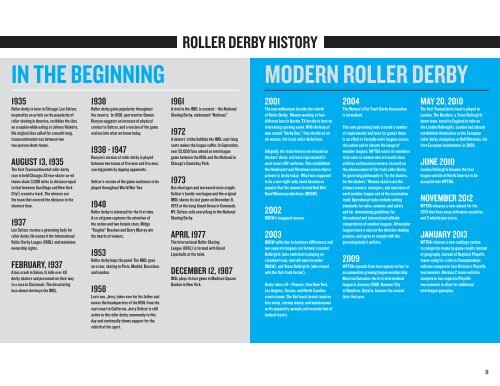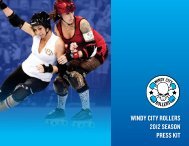to download our Press Kit! - The Windy City Rollers
to download our Press Kit! - The Windy City Rollers
to download our Press Kit! - The Windy City Rollers
Create successful ePaper yourself
Turn your PDF publications into a flip-book with our unique Google optimized e-Paper software.
ROLLER DERBY HISTORY<br />
IN THE BEGINNING MODERN ROLLER DERBY<br />
1935<br />
Roller derby is born in Chicago. Leo Seltzer,<br />
inspired by an article on the popularity of<br />
roller skating in America, scribbles the idea<br />
on a napkin while eating at Johnny Ricketts.<br />
His original idea called for a month-long,<br />
transcontinental race between two<br />
two-person skate teams.<br />
AUGUST 13, 1935<br />
<strong>The</strong> first Transcontinental roller derby<br />
race is held Chicago: 25 two-skater co-ed<br />
teams skate 3,000 miles (a distance equal<br />
<strong>to</strong> that between San Diego and New York<br />
<strong>City</strong>!) around a track. <strong>The</strong> winners are<br />
the team that covered the distance in the<br />
shortest time.<br />
1937<br />
Leo Seltzer creates a governing body for<br />
roller derby. He names it the International<br />
Roller Derby League (IRDL) and maintains<br />
ownership rights.<br />
FEBRUARY, 1937<br />
A bus crash in Salem, IL kills over 40<br />
derby skaters and personnel on their way<br />
<strong>to</strong> a race in Cincinnati. <strong>The</strong> devastating<br />
loss almost destroys the IRDL.<br />
1938<br />
Roller derby gains popularity throughout<br />
the country. In 1938, sportswriter Damon<br />
Runyon suggests an increase of physical<br />
contact <strong>to</strong> Seltzer, and a version of the game<br />
evolves in<strong>to</strong> what we know <strong>to</strong>day.<br />
1938 - 1947<br />
Runyon’s version of roller derby is played<br />
between two teams of five men and five men,<br />
scoring points by lapping opponents.<br />
Seltzer’s version of the game continues <strong>to</strong> be<br />
played throughout World War Two.<br />
1948<br />
Roller derby is televised for the first time.<br />
A co-ed game captures the attention of<br />
the nation and two female stars, Midge<br />
“Toughie” Brashun and Gerry Murray win<br />
the hearts of viewers.<br />
1953<br />
Roller derby hops the pond. <strong>The</strong> IRDL goes<br />
on a <strong>to</strong>ur, skating in Paris, Madrid, Barcelona<br />
and London.<br />
1958<br />
Leo’s son, Jerry, takes over for his father and<br />
moves the headquarters of the IRDL from the<br />
east coast <strong>to</strong> California. Jerry Seltzer is still<br />
active in the roller derby community <strong>to</strong> this<br />
day and continually shows support for the<br />
rebirth of the sport.<br />
1961<br />
A rival <strong>to</strong> the IRDL is created – the National<br />
Skating Derby, nicknamed “National.”<br />
1972<br />
A skaters’ strike hobbles the IRDL and rising<br />
costs makes the league suffer. In September,<br />
over 52,000 fans attend an interleague<br />
game between the IRDL and the National in<br />
Chicago’s Comiskey Park.<br />
1973<br />
Gas shortages and increased costs cripple<br />
Seltzer’s family-run league and the original<br />
IRDL skates its last game on December 8,<br />
1973 at the Long Island Arena in Commack,<br />
NY. Seltzer sells everything <strong>to</strong> the National<br />
Skating Derby.<br />
APRIL 1977<br />
<strong>The</strong> International Roller Skating<br />
League (IRSL) is formed with David<br />
Lipschultz at the helm.<br />
DECEMBER 12, 1987<br />
IRSL plays its last game in Madison Square<br />
Garden in New York.<br />
2001<br />
<strong>The</strong> new millennium heralds the rebirth<br />
of Roller Derby. Women working at f<strong>our</strong><br />
different bars in Austin, TX decide <strong>to</strong> host an<br />
interesting sporting event. With the help of<br />
man named “Derby Dan,” they decide on an<br />
all-woman, flat track roller derby bout.<br />
Allegedly, the team themes were based on<br />
the bars’ décor, and were represented in<br />
each team’s DIY uniforms. This established<br />
the flamboyant and flirtatious nature that is<br />
present in derby <strong>to</strong>day. What was supposed<br />
<strong>to</strong> be a one-night-only event became so<br />
popular that the women formed Bad Girl/<br />
Good Woman productions (BGGW).<br />
2002<br />
BGGW’s inaugural season.<br />
2003<br />
BGGW splits due <strong>to</strong> business differences and<br />
two separate leagues are formed: Lonestar<br />
Rollergirls (who switched <strong>to</strong> playing on<br />
a banked track, and still operate under<br />
BGGW), and Texas Rollergirls (who stayed<br />
with the flat-track format).<br />
Derby takes off—Phoenix, then New York,<br />
Los Angeles, Tucson, and North Carolina<br />
create teams. <strong>The</strong> flat track format requires<br />
less setup, startup money, and maintenance<br />
so its popularity spreads and exceeds that of<br />
banked track’s.<br />
2004<br />
<strong>The</strong> Women’s Flat Track Derby Association<br />
is formalized.<br />
This new governing body created a number<br />
of requirements and bout (or game) dates<br />
in an effort <strong>to</strong> formally unite leagues across<br />
the nation and <strong>to</strong> elevate the image of<br />
member leagues. WFTDA wants its members<br />
<strong>to</strong> be seen as women who are world-class<br />
athletes and business owners, focused on<br />
the advancement of flat track roller Derby.<br />
Its governing philosophy is “by the skaters,<br />
for the skaters.” Women skaters are the<br />
primary owners, managers, and opera<strong>to</strong>rs of<br />
each member league and of the association<br />
itself. Operational tasks include setting<br />
standards for rules, seasons, and safety<br />
and for determining guidelines for<br />
the national and international athletic<br />
competitions of member leagues. All member<br />
leagues have a voice in the decision-making<br />
process, and agree <strong>to</strong> comply with the<br />
governing body’s policies.<br />
2009<br />
WFTDA expands from two regions <strong>to</strong> f<strong>our</strong> <strong>to</strong><br />
accommodate growing league membership.<br />
Montreal becomes the first international<br />
league in January 2009. Hammer <strong>City</strong><br />
of Hamil<strong>to</strong>n, Ontario, became the second<br />
later that year.<br />
MAY 20, 2010<br />
<strong>The</strong> first Transatlantic bout is played in<br />
London. <strong>The</strong> Hustlers, a Texas Rollergirls<br />
home team, travel <strong>to</strong> England <strong>to</strong> take on<br />
the London Rollergirls. London had already<br />
established themselves as the European<br />
roller derby champions at Roll Britannia, the<br />
first European <strong>to</strong>urnament, in 2009.<br />
JUNE 2010<br />
London Rollergirls became the first<br />
league outside of North America <strong>to</strong> be<br />
accepted in<strong>to</strong> WFTDA.<br />
NOVEMBER 2012<br />
WFTDA releases a new ruleset for the<br />
2013 that does away with minor penalties<br />
and 2 whistle jam starts.<br />
JANUARY 2013<br />
WFTDA releases a new rankings system<br />
<strong>to</strong> categorize teams by game results instead<br />
of geography. Instead of Regional Playoffs,<br />
teams vying for a slot in Championships<br />
will now compete in f<strong>our</strong> Division 1 Playoffs<br />
<strong>to</strong>urnaments. Division 2 teams will also<br />
compete in two separate Playoffs<br />
<strong>to</strong>urnaments <strong>to</strong> allow for additional<br />
interleague gameplay.<br />
11



